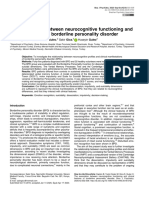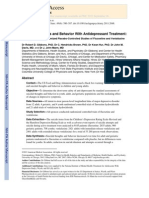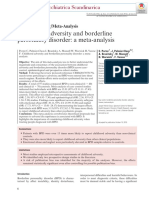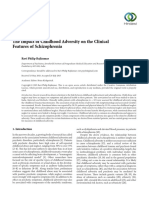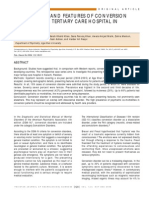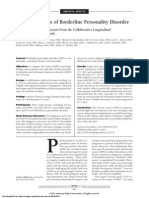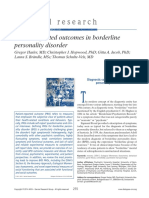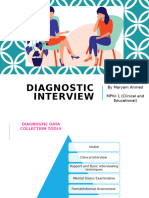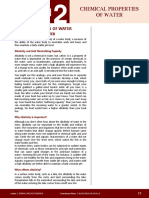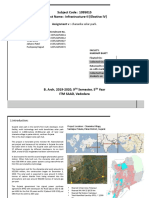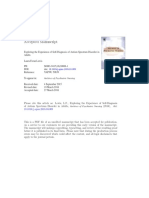editor,+6-523-P-147-153_compressed-2
editor,+6-523-P-147-153_compressed-2
Uploaded by
channahhaniyaCopyright:
Available Formats
editor,+6-523-P-147-153_compressed-2
editor,+6-523-P-147-153_compressed-2
Uploaded by
channahhaniyaCopyright
Available Formats
Share this document
Did you find this document useful?
Is this content inappropriate?
Copyright:
Available Formats
editor,+6-523-P-147-153_compressed-2
editor,+6-523-P-147-153_compressed-2
Uploaded by
channahhaniyaCopyright:
Available Formats
INDICATORS OF CONVERSION DISORDER PATIENTS
BASED ON HUMAN FIGURE DRAWING TEST
Izaz Jamal1, Zainab Ishfaq2, Haadia Hidayat2, Abdul Hai Wazir3, Ijaz Gul1, Pirzada Muhammad
Muneeb1
ABSTRACT
Objective:
To ascertain the typical reactions of conversion patients when asked to draw a human figure;
To explore which bodily organs patients with conversion disorder omit from their drawings;
To analyse the similarities and distinctions between patients who have conversion disorder and
those who do not.
Methods: This cross-sectional study used purposive sampling to select 100 participants, with 50
having conversion disorder and 50 without, from various hospitals and universities. Data were
analyzed using a standard manual. Descriptive statistics assessed demographics, while the chi-
square test evaluated associations between variables. Correlation measures compared conversion
disorder patients to non-conversion participants.
Results: Significant changes in emotional markers are seen between the conversion and non-
conversion patient groups on the human figure drawing test. Notable indicators among conversion
patients include the deletion of the legs and feet (92%), the entire shade of body limbs (100%), and
the shading of the face (96%).
Conclusion: By analysing emotional signs, this study makes a substantial contribution to our
understanding of conversion disorder. The results demonstrate the potential of Human Figure
Drawing as a diagnostic tool, integrate psychodynamic and cognitive-behavioral techniques, and are
consistent with historical perspectives. Through ongoing advancements and expanded
interdisciplinary collaboration, Human Figure Drawing may play a critical part in the diagnostic
process in cases of conversion disorder, enabling early detection and intervention.
Keywords: Conversion disorder, Human Figure Drawing (HFD), Emotional Indicators, Patient Health
Questionnaire (PHQ-15), Diagnostic Tools.
INTRODUCTION Patients present with physical and neurological
symptoms or organic problems that are not
Conversion disorder is a mental illness in detectable by laboratory testing, making
which there is no apparent medical cause for diagnosis challenging. This disorder is
the physical symptoms of psychological stress, categorized as a somatoform disorder in the
such as paralysis or non-epileptic convulsions. Diagnostic and Statistical Manual of Mental
It presents diagnostic issues since symptoms Disorders, Fifth Edition (DSM-V) and a
might mimic neurological or medical diseases. dissociative disorder in the ICD-10. It is
It is frequently associated with trauma or believed that psychological factors1 are the
stress. primary cause of this condition. Children with
_____________________________________ conversion disorder frequently experience
motor symptoms, which emphasizes the
1Mardan Medical Complex, Mardan importance of early psychological intervention
2Clinical Psychologist and reducing patient defensiveness 2. Further
3Institute of Mental Health and Behavioral investigation into the neurological
Sciences Hayatabad, Peshawar underpinnings of conversion disorder has been
prompted by research indicating that
…………………………………………………….. individuals with the condition perform worse on
information processing speed tests when
Address for Correspondence:
compared to those with physical symptoms
Ijaz Gul
and related conditions3.
Professor, Department of Psychiatry, Bacha
Khan Medical Complex, Mardan Historically, hysteria has been associated with
drgullrh@yahoo.com mental illness, and in the 18th century it
became associated with the brain and
developed into the informal term ``conversion
disorder'' by Joseph Breuer and Sigmund
KJMS July – September 2024, Volume 17, No. 3 147
Freud. Freud identified hysterical symptoms as In order to better understand conversion
a defense mechanism to reduce stress caused disorder, this study looks at its diagnostic
by physical disorders. 4. Freud's therapeutic challenges, historical background, and use of
alliance, using catharsis, hypnosis, and free Human Figure Drawing (HFD) to pinpoint
association, aimed to uncover unconscious emotional indications. It especially examines
conflicts related to aggression, sexuality, and whether conversion patients show more
dependence. 5. pronounced indicators on HFD in comparison
to individuals who are not conversion patients,
Rethinking the relationship between behaviour with an emphasis on the body parts that
and its consequences to help patients let go of conversion patients may choose to remove.
symptoms is a behaviourist approach, as The study compares these drawings in an
learning theory posits that individuals assume effort to evaluate the diagnostic potential of
the role of sickness for external rewards. 6. HFD and to emphasise the need for continued
When there are no underlying medical or research using cutting-edge instruments and
neurological conditions, cognitive behavioural technology.
therapy works well; when there are familial
dynamics involved, family therapy is advised. Hypotheses
7, 8. While family therapy, cognitive There is a significant difference of emotional
behavioural therapy, and psychodynamic indicators on HFD of conversion and non-
techniques are acknowledged as effective conversion
means of diagnosing and treating conversion
disorder, there is no definitive hierarchy among
them. 9. A case study demonstrates how well METHOD
a psychodynamic approach to understanding
conversion disorder works, and family Participants
counselling and cognitive behavioural therapy This was a cross sectional study conducted in
are helpful in the treatment process. 10. various hospitals and universities of Peshawar.
A sample of 100 was taken. The sample was
The Human Figure Drawing (HFD) test divided into two groups. The first group
developed by Good enough serves as a comprised of 50 conversion patients data
projective test with 30 emotional indicators. collected from KTH, LRH and Shafiq
Although the HFD test is commonly used for psychiatric hospital), while the other group
self-report, its reliability in assessing comprised of 50 non conversion subjects (data
psychological states needs to be reconsidered collected from students of Islamia college and
given its influence on cognitive style 11. Peshawar university).
The HFD used in this study aims to display Inclusion and Exclusion criteria
emotional indicators in patients with
conversion disorder and address the Male and female patients presenting with
psychological and emotional aspects of this conversion disorder ranging in age from 18 to
condition. Research suggests that several 35 years were selected. All those patients
affective indicators of HFD can predict were excluded who had psychiatric comorbid
affective disorders in clinical patients 12. disorder other than conversion disorder, head
Studies comparing alleged and non-victims of injury, and serious medical conditions. For
sexual abuse found no statistically significant non-conversion participants, all those male
differences, but certain indicators such as and female students who did not had
clenched legs, large hands, and genitalia are conversion disorder or other psychiatric
more common in the former, suggesting higher disorders ranging in age from 18 to 35 years
levels of anxiety. were selected from University of Peshawar
and Islamia College.
The potential of human figure drawing (HFD)
as a tool for identifying emotional markers Measures
linked to conversion disorder is explored in this A demographic data sheet was created for
study. Numerous studies into the application of gathering data in important demographic
HFD in this context have yielded insightful details like age, gender, education level,
information about its possible efficacy. The marital status, socio-economic class, and other
research undertaken during this time is information regarding medical or psychological
reviewed in this discussion, which also treatment.
emphasises how HFD can help with
conversion disorder assessment and Instruments
comprehension. Somatization (PHQ-15)
148 KJMS July – September 2024, Volume 17, No. 3
PHQ was used to assess somatic symptoms Procedure
among the participants. PHQ is an adaptation
of the 15-item Patient Health Assessment 14. For research and data collection, we visited
Physical Symptom Questionnaire (PHQ-15) various hospitals and universities depending
assesses areas of physical symptoms. on the purpose of the study. A consent form
Human Figure Drawing explaining the research project as well as
demographic forms and questionnaires were
Human Figure Drawing 15 was used to provided to the hospital authorities involved.
measure emotional indicators in adolescent After obtaining the necessary permissions, we
and conversion patients. It is used by contacted participants. The researcher
adolescents and adults between the ages of contacted the hospital staff and informed them
18 and 35. This scale consists of 30 present or of the purpose of the study to obtain the
absent items (1 or 0). Koppitz determined the required sample consisting of 50 conversion
reliability of the HFD on effective indicators. patients and 50 non-conversion patients.
Internal consistency coefficients ranged from Subjects were given instructions. After all data
0.94 to 0.9615. the test was interpreted by were collected, all scales were analysed using
trained psychologists. a standard manual.
RESULTS
Table 1: Comparison of HFD TOT and PHQ TOT Scores between Conversion and Non-Conversion
Groups
Mean t- p- Cohen’s 95%
Measure Group Mean SD Difference value value d CI
Conversion [2.10,
HFD (n=50) 3.96 1.65 2.7 9.06 <.001 1.82 3.29]
Non-
Conversion 1.26 1.65
[14.8,
PHQ Conversion 21.9 3.60 16.3 22.4 < .001 4.49 17.7]
Non-
Conversion 5.60 3.60
Note: SD = Standard Deviation; CI = Confidence Interval.
Table 2. Descriptive Statistics and Correlations for PHQ TOT and HFD TOT Scores by Group
Measure Group Mean SD t-value Correlation Correlation
with PHQ with HFD
PHQ Conversion 21.99 3.60 - 1.000 0.331
HFD Conversion 5.66 3.67 - 0.331 1.000
PHQ Non- 5.60 3.60 - 1.000 -
Conversion
HFD No- 1.26 1.30 - - 1.000
Conversion
Table 3. Comparison of Prevalence of Specific Features between Conversion and Non-Conversion
Groups
Parts Con (%) Non-Con (%) p-value
Poor Integration 28 56 < .001
Shading of Face 4 96 > 1.0
Shading of 4 100 >0.2
Body/Limbs
Shading of 44 75 >0.5
Hands/Neck
Gross Asymmetry 32 2 < .001
Limbs
KJMS July – September 2024, Volume 17, No. 3 149
Slanting Figure 0 100 >0.5
Tiny Figure 52 94 <.001
Big Figure 46 12 >0.6
Transparencies 6 94 >0.1
Tiny Head 4 98 >0.5
p-values are reported for the comparison of proportions between Conversion (Con) and Non-
Conversion (Non-con) groups. Statistical significance is considered at p < .05.
Table 4: Comparison of Features between Conversion and Non-Conversion Groups
Features Con (%) Non-con (%) χ² Odds Ratio p-value
Grossed Eye 74.0 16.0 8.69 - <.003
Teeth 2.0 2.0 0.000 1.00 >0.7
Short Arm 42.0 4.0 34.0 0.030 <.000
Long Arms 98.0 24.0 1.01 - >0.5
Arms Clinging 92.0 28.0 6.77 4.47 <.009
Big Hands 0 0 N/A N/A N/A
Hands Cut Off 54.0 90.0 16.0 0.130 <.000
Leg Pressed Together 75.0 86.0 4.89 7.97 <.03
Genitals 0 100.0 N/A N/A N/A
Monster Figure 980 2.0 1.01 - >0.5
Table 5: No Response Features
Features Con (%) Non-con (%) χ² Odds Ratio p-value
Three or More Figures 0 0 N/A N/A N/A
Cloud, Rain, Snow 0 0 N/A N/A N/A
No Eye 58.0 88.0 11.4 0.188 <.001
Results: Significant differences in emotional indicators are observed between conversion and non-
conversion groups on HFD. Notable indicators include shading of body limbs (100%), shading of the
face (96%), and omission of legs and feet (92%) among conversion patients. Specific drawing
features such as hands cut-off and tiny figures emerge as consistent identifiers.
DISCUSSION Drawing (HFD) as a diagnostic tool for
identifying these markers. The HFD has found
Conversion disorder, a complex psychiatric several important emotional indications, such
condition, is marked by physical symptoms as the omission of the legs and feet, the shade
that cannot be attributed to underlying medical of the face, and the shading of body limbs. In
or neurological conditions. Recognizing particular, 100% of the drawings had body limb
emotional markers is crucial for accurate shading, 96% had facial shading, and 92% did
diagnosis and effective treatment. This study not include any legs or feet. In patients with
highlights the potential of Human Figure
150 KJMS July – September 2024, Volume 17, No. 3
conversion disorder, these markers are linked precisely distinguish between instances that
to symptoms of anxiety, psychosomatic convert and those that do not.
problems, and feelings of insecurity.
Recent literature supports integrating
The results of this study support other studies advanced diagnostic technologies, such as
on the use of HFD in the diagnosis of neuroimaging, to enhance the accuracy of
conversion disorder. Smith et al. (2020) diagnosing conversion disorder. Studies also
showed that in 100 patients with conversion emphasize the importance of considering
disorder, HFD could detect emotional signals cultural factors and individual differences in the
such clenched fists, missing facial features, manifestation and diagnosis of the disorder,
and skewed body proportions. Their results advocating for a holistic approach. The
highlight the potential of HFD to uncover exploration of potential biomarkers and genetic
emotional states that facilitate diagnosis. factors further opens new research avenues,
Likewise, HFD was assessed by Brown and offering deeper insights into the condition.
Jones (2022) as an additional diagnostic tool
for conversion disorder. They found signs such However, several limitations of HFD in
as increased limb length and disjointed body diagnosing conversion disorder must be
parts in their study of fifty people with addressed. Subjective interpretation of
conversion disorder, which supports the use of drawings and variations in artistic ability
HFD in clinical evaluations. among patients may introduce bias. Previous
studies have highlighted the need for
The research works effectively with the body of standardized scoring systems and replication
knowledge already available on conversion research to validate HFD’s effectiveness.
condition. The complexity of conversion These concerns echo the findings of this
disorder is reflected in its historical viewpoint, study, underscoring the necessity for more
which saw the ailment evolve from hysteria to objective methods and consistent evaluation
its current understanding. The findings echoes criteria.
previous research that confirms the prevalence
of motor symptoms in children with conversion In summary, by emphasising particular
disorder and highlights the significance of early emotional characteristics, this study supports
psychological intervention. Furthermore, the the usefulness of HFD in the diagnosis of
research's analysis of the influence of conversion disorder. The study's conclusions
cognitive processing is consistent with recent are in line with earlier research, suggesting
investigations on the neurobiological features that HFD can offer important insights into the
of conversion disorder. disorder's emotional dimensions. The study
admits its shortcomings, including the lack of
The study also acknowledges the contributions standardised grading and subjective
of psychodynamic approaches to interpretation, despite its potential.
understanding conversion disorder. Freud’s Subsequent investigations ought to tackle
early work on hysteria highlighted the these constraints, incorporate HFD with
importance of techniques such as catharsis, sophisticated diagnostic tools, and take
hypnosis, and free association. While these cultural aspects into account to augment
approaches are foundational, the study comprehension and therapy of conversion
advocates for a multi-faceted therapeutic disorder. The study emphasises the
strategy that combines psychodynamic, significance of methodological developments
cognitive-behavioral, and family therapies. and ongoing research to close the gap
This reflects current practices that integrate between the psychological and somatic
various therapeutic modalities for a aspects of conversion disorder, ultimately
comprehensive approach to managing leading to improved diagnosis and treatment.
conversion disorder.
CONCLUSION
The investigation on the function of HFD adds
to the current discourse around enhancing In conclusion, by using Human Figure Drawing
diagnostic precision. Conversion disorder's (HFD) to examine emotional markers, this
psychological aspects can be better research advances our understanding of
understood by identifying emotional conversion disorder. The results support
indications, such as body part omission and earlier theories about the condition,
limb darkening. This demonstrates HFD's incorporate cognitive-behavioral and
potential as an additional diagnostic tool. psychodynamic theories, and highlight the
When combined with other diagnostic utility of HFD as a diagnostic tool. Significant
techniques, HFD may help clinicians more differences in emotional indicators are found
between the conversion and non-conversion
KJMS July – September 2024, Volume 17, No. 3 151
groups in this study. Notable characteristics by ongoing multidisciplinary research and
include the omission of the legs and feet in methodological developments.
individuals with conversion disorder and the
shading of the face and body limbs. Cut-off
hands and small people have become REFERENCES
common identifying elements in drawings.
1. Roelofs K, van Galen GP, JKeijsers G,
The findings of the study imply that HFD can LHoogduin C. Motor initiation and
be a useful additional diagnostic tool for execution in patients with conversion
conversion disorder, providing information on paralysis. Acta Psychol. 2002;110(1):21-
psychological and emotional elements that 34.
may support a diagnosis. This research offers
a framework for optimising therapeutic 2. Khan F, Bhimani M, Arfeen T, Zaman M.
interventions and diagnostic techniques by Conversion disorder in young people of
identifying 11 distinct emotional indicators, Karachi. Isra Med J. 2014;6(4):285-288.
including shadows on limbs, face, hands, and
3. Vroege LD, Koppenol I, Kop WJ, Riem
neck; small figures; missing legs and feet;
MM, van der Feltz M. Neurocognitive
compressed legs; amputated hands; missing
functioning in patients with conversion
arms; arms placed on the side of the body; disorder/functional neurological disorder.
dangling; eyeless; and poorly integrated body PubMed.gov. 2021;69-87.
parts.
4. Rubinstein BB. Freud’s Early Theories of
LIMITATIONS OF THE STUDY
Hysteria. In: Rubinstein BB, editor.
There are various limitations of the study. The Physics, Philosophy and Psychoanalysis.
limited sample size limits how far the results Springer, Dordrecht; 1983. p. 169-170.
may be applied. Time constraints prevented
5. Winer JA. The New Psychiatric Texts and
data collection from being conducted beyond Psychoanalysis. J Am Psychoanal Assoc.
three hospitals, which reduced the sample's 1997;45:941-958.
diversity. Furthermore, there was a difference
in the level of education of the two groups; all 6. Shahid Ali, Jabeen S, Pate RJ, Shahid M,
non-conversion participants were educated, Chinala S, Nathani M, Shah R. Conversion
but about half of the conversion patients were Disorder—Mind versus Body. National
not, which could have an effect on the Library of Medicine. 2015;27–33.
outcomes.
7. Allen LA. Cognitive behavioral therapy for
RECOMMENDATIONS somatoform disorders. Psychiatric Clinics.
2010;33:579-593.
In order to improve generalisability, future
research should endeavour to overcome the 8. Moene FC, Landberg EH, Hoogduin KA,
constraints of the current study by utilising Spinhoven P. Organic syndromes
bigger, randomly selected samples. diagnosed as conversion disorder:
Broadening the scope of data gathering to identification and frequency in a study of
encompass several hospitals throughout the 85 patients. J Psychosom Res. 2000;49:7-
province will yield a more comprehensive 12.
outlook. Ensuring appropriate psychological
evaluation of participants will enhance the 9. Matthew Allin, Streeruwitz A, Cu V.
interpretations' validity and reliability. Bias can Progress in understanding conversion
be reduced by matching the educational disorder. National Library of Medicine.
attainment of the conversion and non- 2005;205–209.
conversion groups.
10. Yousaf T. Case History and Treatment of
Future research should also build a Conversion Disorder. Ahria J Prof
standardised scoring systems, compare HFD Psychol. 2013;12:86-94.
results with other diagnostic instruments, and
11. Basgul SS, Uneri OS, Akkaya GB, Etiler
use longitudinal designs to look at how
N, Coskun A. Assessment of drawing age
emotional markers change over time. This
of children in early childhood and its
strategy will improve knowledge of and care
correlates. Psychology. 2011 Jul
for individuals with conversion disorder. HFD's
1;2(4):376.
involvement in early conversion disorder
12. Koppitz EM. Emotional indicators on
detection and intervention will be strengthened
human figure drawings of shy and
152 KJMS July – September 2024, Volume 17, No. 3
aggressive children. J Clin Psychol. 16. Smith A, Johnson B, White C. Emotional
1996;52:466-469. indicators of conversion disorder through
human figure drawing. J Psychiatr Res.
13. Hartman HG, Hibbard H. Emotional 2020;125:45-51.
indicators in human figure drawings of
sexually victimized and nonabused 17. Brown R, Jones L. Human figure drawing
children. J Clin Psychol. 1990;46:211–219. as an adjunctive diagnostic tool for
conversion disorder. Clin Psychol Rev.
14. Kroenke K, Spitzer RL, Williams JB. The 2022;78:101829.
PHQ-15: validity of a new measure for
evaluating the severity of somatic 18. Catte M. Emotional indicators in children's
symptoms. Psychosomatic medicine. 2002 human figure drawings [Unpublished
Mar 1;64(2):258-66. doctoral dissertation]. University of Leeds;
15. Koppitz EM. Psychological evaluation of 1999. [cited 2024 Mar 29]. Available from:
children's human figure drawings. Grune & https://etheses.whiterose.ac.uk/2464/1/DX
Stratton; 1968. 208299.pdf
KJMS July – September 2024, Volume 17, No. 3 153
You might also like
- Kobbacy, Murthy - Complex System Maintenance Handbook100% (2)Kobbacy, Murthy - Complex System Maintenance Handbook648 pages
- A Randomized Controlled Trial of Group Reality TheNo ratings yetA Randomized Controlled Trial of Group Reality The6 pages
- The Relationship of Cognitive Functions and Psychopathology On The Level of Insight in Patients With SchizophreniaNo ratings yetThe Relationship of Cognitive Functions and Psychopathology On The Level of Insight in Patients With Schizophrenia6 pages
- Psychiatric Epidemiology of Transgender and Nonbinary Adult Patients at An Urban Health CenterNo ratings yetPsychiatric Epidemiology of Transgender and Nonbinary Adult Patients at An Urban Health Center11 pages
- Psychiatric Disorders in Individuals Diagnosed With Gender Dysphoria: A Systematic ReviewNo ratings yetPsychiatric Disorders in Individuals Diagnosed With Gender Dysphoria: A Systematic Review6 pages
- Neurocognitive Assessments Transgender Adults - LTNo ratings yetNeurocognitive Assessments Transgender Adults - LT14 pages
- Pedophilia, Minor-Attracted Persons, and The DSM100% (3)Pedophilia, Minor-Attracted Persons, and The DSM12 pages
- NIH Public Access: Suicidal Thoughts and Behavior With Antidepressant TreatmentNo ratings yetNIH Public Access: Suicidal Thoughts and Behavior With Antidepressant Treatment15 pages
- Behavior profile of children with nephrotic syndromeNo ratings yetBehavior profile of children with nephrotic syndrome6 pages
- Feasibility and inter-rater reliability.No ratings yetFeasibility and inter-rater reliability.30 pages
- Healthpsychologyresearch 2022 10-4-38674No ratings yetHealthpsychologyresearch 2022 10-4-3867415 pages
- Cognition of Schizophrenic Inpatients and Healthy Individuals: Casual-Comparative StudyNo ratings yetCognition of Schizophrenic Inpatients and Healthy Individuals: Casual-Comparative Study6 pages
- Behavioral and Psychological Symptoms Impact Clinical Competence in AlzheimerNo ratings yetBehavioral and Psychological Symptoms Impact Clinical Competence in Alzheimer13 pages
- 36 - Decision-Making and Risk-Taking in Forensic and Non-Forensic Patients With Schizophrenia Spectrum Disorders A Multicenter European StudyNo ratings yet36 - Decision-Making and Risk-Taking in Forensic and Non-Forensic Patients With Schizophrenia Spectrum Disorders A Multicenter European Study8 pages
- Factor Structure Analysis, Validity and Reliability of The Health Anxiety Inventory-Short FormNo ratings yetFactor Structure Analysis, Validity and Reliability of The Health Anxiety Inventory-Short Form7 pages
- Exploring The Clinical Utility of The DSM-5 Conduct Disorder Specifier of With Limited Prosocial Emotions' in An Adolescent Inpatient SampleNo ratings yetExploring The Clinical Utility of The DSM-5 Conduct Disorder Specifier of With Limited Prosocial Emotions' in An Adolescent Inpatient Sample16 pages
- Meta-Analysis of Neuropsychological Functioning in Euthymic Bipolar Disorder: An Update and Investigation of Moderator VariablesNo ratings yetMeta-Analysis of Neuropsychological Functioning in Euthymic Bipolar Disorder: An Update and Investigation of Moderator Variables9 pages
- Acute Medical Workup for New-Onset Psychosis in ChildrenNo ratings yetAcute Medical Workup for New-Onset Psychosis in Children10 pages
- Articulo Psiquiatria DR. Eduardo Castelazo GrafftNo ratings yetArticulo Psiquiatria DR. Eduardo Castelazo Grafft11 pages
- Cognitive Impairment in Late-Life Generalized Anxiety DisorderNo ratings yetCognitive Impairment in Late-Life Generalized Anxiety Disorder7 pages
- Psychopathological Aspects of Body Dysmorphic Disorder A Literature ReviewNo ratings yetPsychopathological Aspects of Body Dysmorphic Disorder A Literature Review6 pages
- The Relationship Between Schizo-Affective, Schizophrenic and Mood Disorders in Patients Admitted at Mathari Psychiatric Hospital, Nairobi, KenyaNo ratings yetThe Relationship Between Schizo-Affective, Schizophrenic and Mood Disorders in Patients Admitted at Mathari Psychiatric Hospital, Nairobi, Kenya8 pages
- Avaliando A Carga de Doença Associada Ao Transtorno de Desejo Sexual Hipoativo Generalizado Adquirido.No ratings yetAvaliando A Carga de Doença Associada Ao Transtorno de Desejo Sexual Hipoativo Generalizado Adquirido.11 pages
- Comordity and diagnostis distribution in transdiagnostic treatments for emotional disordersNo ratings yetComordity and diagnostis distribution in transdiagnostic treatments for emotional disorders31 pages
- Literature Review of Risk Factors and Interventions On Postpartum DepressionNo ratings yetLiterature Review of Risk Factors and Interventions On Postpartum Depression7 pages
- Clinical Research: Patient-Reported Outcomes in Borderline Personality DisorderNo ratings yetClinical Research: Patient-Reported Outcomes in Borderline Personality Disorder12 pages
- Diagnosis of Personality Disorder in AdolescentsNo ratings yetDiagnosis of Personality Disorder in Adolescents4 pages
- Is Adult ADHD a Childhood-Onset Neurodevelopmental Disorder? Evidence From a Four-Decade Longitudinal Cohort StudyNo ratings yetIs Adult ADHD a Childhood-Onset Neurodevelopmental Disorder? Evidence From a Four-Decade Longitudinal Cohort Study11 pages
- Evaluación de Funciones Cognitivas: Atención y Memoria en Pacientes Con Trastorno de PánicoNo ratings yetEvaluación de Funciones Cognitivas: Atención y Memoria en Pacientes Con Trastorno de Pánico8 pages
- Epilepsy & Behavior: Shanna M. Guilfoyle, Sally Monahan, Cindy Wesolowski, Avani C. ModiNo ratings yetEpilepsy & Behavior: Shanna M. Guilfoyle, Sally Monahan, Cindy Wesolowski, Avani C. Modi6 pages
- Impact of Psychosis in Bipolar Disorder During Manic EpisodesNo ratings yetImpact of Psychosis in Bipolar Disorder During Manic Episodes16 pages
- Brief Symptoms Inventory Psychometric PropertiesNo ratings yetBrief Symptoms Inventory Psychometric Properties19 pages
- The Role of Neuropsychological AssessmentNo ratings yetThe Role of Neuropsychological Assessment28 pages
- The Medical-Social and the Forensic-Psychiatric Aspects of Gerontology and Geriatric PsychiatryFrom EverandThe Medical-Social and the Forensic-Psychiatric Aspects of Gerontology and Geriatric PsychiatryNo ratings yet
- early childhood cognitive development ( Preoperational stage) 3No ratings yetearly childhood cognitive development ( Preoperational stage) 319 pages
- 6--COPING-RESPONSES-INVENTORY------CRI--03062022-122909pm-08052024-014353pmNo ratings yet6--COPING-RESPONSES-INVENTORY------CRI--03062022-122909pm-08052024-014353pm38 pages
- Chapter 6 - Informed Consent - Summary of Informed Consent - Ethics in Counseling and Psychotherapy by Elizabeth RNo ratings yetChapter 6 - Informed Consent - Summary of Informed Consent - Ethics in Counseling and Psychotherapy by Elizabeth R20 pages
- 3---Personality-Assessment-Inventory-ppt-29032021-100704pm-16052024-053535pmNo ratings yet3---Personality-Assessment-Inventory-ppt-29032021-100704pm-16052024-053535pm66 pages
- Chapter 5- Confidentiality - Detailed Summary - Ethics in Counseling and Psychotherapy by Elizabeth RNo ratings yetChapter 5- Confidentiality - Detailed Summary - Ethics in Counseling and Psychotherapy by Elizabeth R38 pages
- PERSONALITY-DISORDERS-and-its-etiology-18012022-030524pm-11012023-034321pm (1)No ratings yetPERSONALITY-DISORDERS-and-its-etiology-18012022-030524pm-11012023-034321pm (1)68 pages
- Week # 1 Foundation of Research MethodsNo ratings yetWeek # 1 Foundation of Research Methods23 pages
- Anatomy of Abuse & Trauma David BedrickNo ratings yetAnatomy of Abuse & Trauma David Bedrick10 pages
- 1 - Diagnostic Interview and MSE with SkillsNo ratings yet1 - Diagnostic Interview and MSE with Skills44 pages
- 5-Transactional-Analysis-Part-1-12052024-043009amNo ratings yet5-Transactional-Analysis-Part-1-12052024-043009am21 pages
- Childhood Milestones: A Reason For Concern?No ratings yetChildhood Milestones: A Reason For Concern?30 pages
- 11th LectureHistory of Autism Spectrum DisorderNo ratings yet11th LectureHistory of Autism Spectrum Disorder34 pages
- Implicit & Explicit Finite Element Analysis - CAE ANALYSISNo ratings yetImplicit & Explicit Finite Element Analysis - CAE ANALYSIS2 pages
- Failure of TRLY and TREG Card in MARK VI-OCT09pdf PDFNo ratings yetFailure of TRLY and TREG Card in MARK VI-OCT09pdf PDF5 pages
- API 7-1 1st-Edition Addendum-4 February 2019No ratings yetAPI 7-1 1st-Edition Addendum-4 February 20194 pages
- 04 Module 2 Lesson 2 Chemical Properties of WaterNo ratings yet04 Module 2 Lesson 2 Chemical Properties of Water9 pages
- 10.1016/j.apnu.2016.03.009: Archives of Psychiatric NursingNo ratings yet10.1016/j.apnu.2016.03.009: Archives of Psychiatric Nursing28 pages
- Course Outline: First Semester, AY 2021 - 2022No ratings yetCourse Outline: First Semester, AY 2021 - 20223 pages
- University of Madras: Bachelor of Computer Applications (Bca) Degree ProgrammeNo ratings yetUniversity of Madras: Bachelor of Computer Applications (Bca) Degree Programme2 pages
- Section 02 - The Hazards of Flood Cleanup OperationsNo ratings yetSection 02 - The Hazards of Flood Cleanup Operations22 pages
- Plant Systematics A Phylogenetic Approach 4th Edition Walter S. Judd all chapter instant downloadNo ratings yetPlant Systematics A Phylogenetic Approach 4th Edition Walter S. Judd all chapter instant download36 pages
- Kobbacy, Murthy - Complex System Maintenance HandbookKobbacy, Murthy - Complex System Maintenance Handbook
- A Randomized Controlled Trial of Group Reality TheA Randomized Controlled Trial of Group Reality The
- The Relationship of Cognitive Functions and Psychopathology On The Level of Insight in Patients With SchizophreniaThe Relationship of Cognitive Functions and Psychopathology On The Level of Insight in Patients With Schizophrenia
- Psychiatric Epidemiology of Transgender and Nonbinary Adult Patients at An Urban Health CenterPsychiatric Epidemiology of Transgender and Nonbinary Adult Patients at An Urban Health Center
- Psychiatric Disorders in Individuals Diagnosed With Gender Dysphoria: A Systematic ReviewPsychiatric Disorders in Individuals Diagnosed With Gender Dysphoria: A Systematic Review
- Neurocognitive Assessments Transgender Adults - LTNeurocognitive Assessments Transgender Adults - LT
- NIH Public Access: Suicidal Thoughts and Behavior With Antidepressant TreatmentNIH Public Access: Suicidal Thoughts and Behavior With Antidepressant Treatment
- Behavior profile of children with nephrotic syndromeBehavior profile of children with nephrotic syndrome
- Cognition of Schizophrenic Inpatients and Healthy Individuals: Casual-Comparative StudyCognition of Schizophrenic Inpatients and Healthy Individuals: Casual-Comparative Study
- Behavioral and Psychological Symptoms Impact Clinical Competence in AlzheimerBehavioral and Psychological Symptoms Impact Clinical Competence in Alzheimer
- 36 - Decision-Making and Risk-Taking in Forensic and Non-Forensic Patients With Schizophrenia Spectrum Disorders A Multicenter European Study36 - Decision-Making and Risk-Taking in Forensic and Non-Forensic Patients With Schizophrenia Spectrum Disorders A Multicenter European Study
- Factor Structure Analysis, Validity and Reliability of The Health Anxiety Inventory-Short FormFactor Structure Analysis, Validity and Reliability of The Health Anxiety Inventory-Short Form
- Exploring The Clinical Utility of The DSM-5 Conduct Disorder Specifier of With Limited Prosocial Emotions' in An Adolescent Inpatient SampleExploring The Clinical Utility of The DSM-5 Conduct Disorder Specifier of With Limited Prosocial Emotions' in An Adolescent Inpatient Sample
- Meta-Analysis of Neuropsychological Functioning in Euthymic Bipolar Disorder: An Update and Investigation of Moderator VariablesMeta-Analysis of Neuropsychological Functioning in Euthymic Bipolar Disorder: An Update and Investigation of Moderator Variables
- Acute Medical Workup for New-Onset Psychosis in ChildrenAcute Medical Workup for New-Onset Psychosis in Children
- Cognitive Impairment in Late-Life Generalized Anxiety DisorderCognitive Impairment in Late-Life Generalized Anxiety Disorder
- Psychopathological Aspects of Body Dysmorphic Disorder A Literature ReviewPsychopathological Aspects of Body Dysmorphic Disorder A Literature Review
- The Relationship Between Schizo-Affective, Schizophrenic and Mood Disorders in Patients Admitted at Mathari Psychiatric Hospital, Nairobi, KenyaThe Relationship Between Schizo-Affective, Schizophrenic and Mood Disorders in Patients Admitted at Mathari Psychiatric Hospital, Nairobi, Kenya
- Avaliando A Carga de Doença Associada Ao Transtorno de Desejo Sexual Hipoativo Generalizado Adquirido.Avaliando A Carga de Doença Associada Ao Transtorno de Desejo Sexual Hipoativo Generalizado Adquirido.
- Comordity and diagnostis distribution in transdiagnostic treatments for emotional disordersComordity and diagnostis distribution in transdiagnostic treatments for emotional disorders
- Literature Review of Risk Factors and Interventions On Postpartum DepressionLiterature Review of Risk Factors and Interventions On Postpartum Depression
- Clinical Research: Patient-Reported Outcomes in Borderline Personality DisorderClinical Research: Patient-Reported Outcomes in Borderline Personality Disorder
- Is Adult ADHD a Childhood-Onset Neurodevelopmental Disorder? Evidence From a Four-Decade Longitudinal Cohort StudyIs Adult ADHD a Childhood-Onset Neurodevelopmental Disorder? Evidence From a Four-Decade Longitudinal Cohort Study
- Evaluación de Funciones Cognitivas: Atención y Memoria en Pacientes Con Trastorno de PánicoEvaluación de Funciones Cognitivas: Atención y Memoria en Pacientes Con Trastorno de Pánico
- Epilepsy & Behavior: Shanna M. Guilfoyle, Sally Monahan, Cindy Wesolowski, Avani C. ModiEpilepsy & Behavior: Shanna M. Guilfoyle, Sally Monahan, Cindy Wesolowski, Avani C. Modi
- Impact of Psychosis in Bipolar Disorder During Manic EpisodesImpact of Psychosis in Bipolar Disorder During Manic Episodes
- The Medical-Social and the Forensic-Psychiatric Aspects of Gerontology and Geriatric PsychiatryFrom EverandThe Medical-Social and the Forensic-Psychiatric Aspects of Gerontology and Geriatric Psychiatry
- early childhood cognitive development ( Preoperational stage) 3early childhood cognitive development ( Preoperational stage) 3
- 6--COPING-RESPONSES-INVENTORY------CRI--03062022-122909pm-08052024-014353pm6--COPING-RESPONSES-INVENTORY------CRI--03062022-122909pm-08052024-014353pm
- Chapter 6 - Informed Consent - Summary of Informed Consent - Ethics in Counseling and Psychotherapy by Elizabeth RChapter 6 - Informed Consent - Summary of Informed Consent - Ethics in Counseling and Psychotherapy by Elizabeth R
- 3---Personality-Assessment-Inventory-ppt-29032021-100704pm-16052024-053535pm3---Personality-Assessment-Inventory-ppt-29032021-100704pm-16052024-053535pm
- Chapter 5- Confidentiality - Detailed Summary - Ethics in Counseling and Psychotherapy by Elizabeth RChapter 5- Confidentiality - Detailed Summary - Ethics in Counseling and Psychotherapy by Elizabeth R
- PERSONALITY-DISORDERS-and-its-etiology-18012022-030524pm-11012023-034321pm (1)PERSONALITY-DISORDERS-and-its-etiology-18012022-030524pm-11012023-034321pm (1)
- Implicit & Explicit Finite Element Analysis - CAE ANALYSISImplicit & Explicit Finite Element Analysis - CAE ANALYSIS
- Failure of TRLY and TREG Card in MARK VI-OCT09pdf PDFFailure of TRLY and TREG Card in MARK VI-OCT09pdf PDF
- 10.1016/j.apnu.2016.03.009: Archives of Psychiatric Nursing10.1016/j.apnu.2016.03.009: Archives of Psychiatric Nursing
- University of Madras: Bachelor of Computer Applications (Bca) Degree ProgrammeUniversity of Madras: Bachelor of Computer Applications (Bca) Degree Programme
- Section 02 - The Hazards of Flood Cleanup OperationsSection 02 - The Hazards of Flood Cleanup Operations
- Plant Systematics A Phylogenetic Approach 4th Edition Walter S. Judd all chapter instant downloadPlant Systematics A Phylogenetic Approach 4th Edition Walter S. Judd all chapter instant download







